Text
Hyperbole & A Half; Illustrated Novels as Gateways to More Traditional Comics
Hyperbole and a Half, autobiographical webcomic blog, turned illustrated novel; One! Hundred! Demons!, autobiographical comic compilation of personal “demons;” both detail the funny, heartwarming, and often ugly parts of the human experience as they unfold for each author as an individual. Both are told in short story form, with an intra-homodiagetic narrator (the author serves as both narrator and active character), accompanied by illustrated panels that invoke a sense of physical and emotional movement that the reader can easily conceptualize. With so many major similarities, why does each work receive such different classifications? What makes a comic a comic and not an illustrated novel? How do these seemingly disparate definitions affect the way we read them? Can illustrated novels be considered gateway materials to comics? I think so. Before we jump into that exact why, let’s look at the defining characteristics of comics.
Text, images, and some semblance of sequential flow in time and space are the most major markers of comics, utilized throughout history, found in ancient work like Egyptian tomb paintings all the way up to modern comics and manga. Speech bubbles erupt from the mouths of static character images, narration is often delineated by straight-lined boxes and a change in tone, real movement through space and time happens in the empty “gutters” between panels. Although illustrated novels and comics are constructed differently, they are still processed in the brain in fundamentally the same way. Children’s literacy researcher, Evelyn Arizpe, notes that when reading illustrated stories, regardless of form (comics or traditional storybooks), “the eye moves between one part of the picture and another, piecing together the image like a puzzle.” If picture books and comics are processed in the brain in the same way, why are they considered different mediums? Linguist and cognitive scientist, Neil Cohn, applies his academic specialties to comics, attributing the difference to things like panel placement and what he calls “navigational structure,” the direction our eyes track when piecing images in a comic together to create a sense of coherence when reading.
Traditional storybooks, unlike comics, typically utilize one image per page to convey everything from character relationships to arrested motion; comics achieve a more fluid and nuanced version of this by using panels as snapshots or windows into character worlds. Where then does the illustrated novel fall between these two states, and where does Hyperbole and a Half land? Illustrated novels rely more heavily on the text narrative of the story and the readers imagination, associated images usually only serve to enhance the story world or solidify ideas and images that would otherwise be difficult to conceptualize or to emphasize an exciting or emotional moment in the narrative. Hyperbole and a Half leans more heavily toward the multiple-panel style of comics to help amplify the narrative. Perhaps this stems from the novel’s genesis as a blog-turned-book. In 2009, Hyperbole and a Half author, Allie Brosh began a blog of the same name, where she chronicled events from her personal life, like the adoption of one of her two dogs; illustrated pet peeves, like the internet usage of “alot,” a misspelling of “a lot,” personified as a shaggy, fang-toothed monster; or her fear of spiders, captured by an image of an oval with spindly appendages replete with strapped-on knives, guns, and a swastika tattooed above the eyes. Brosh’s book maintains the same familiar tone, regularly interspersing images meticulously drawn by the author herself. Her use of illustrated images that convey character motion, emotional state, and even dialogue exchanges are reminiscent of both regular comics and contemporary memes.
In Brosh’s chapter titled “Motivation,” she chronicles her own struggle with self-starting and follow-through. She illustrates a frequent conversation she has between the “her” who knows she must complete a task, and the “her” who continues to procrastinate for no conceivable reason. Instead of floating thought bubbles, she makes this conversation concrete by utilizing a kind of split screen effect,where both versions of herself take up space within the same panel, as does their dialogue.

Most of Brosh’s panels behave in the same way, providing the reader with concrete examples of often abstract concepts, like internal monologue and discussions with oneself.
One! Hundred! Demons!author, Lynda Barry, achieves this same concept by forcefully changing the reader’s perspective. As she reveals the story of her struggle with impostor syndrome as an author and her childhood tendency to let her imagination run away with the descriptions in the Classified section of the newspaper, the reader follows her through her childhood musings and is dropped into the middle of one of her fantastical plots.
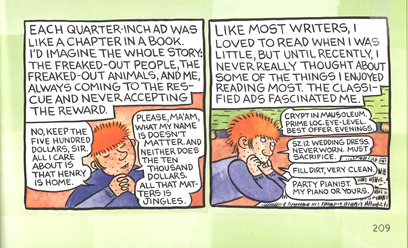
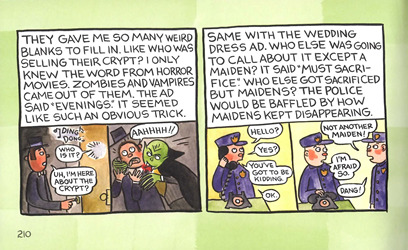
Only when Barry transitions back to a narrative focused on her own more present-tense position as a narrator do we as readers get dragged back into the present-past-tense of her childhood self.

Brosh maintains a slightly smoother sense of temporal immediacy by clumping her panels in “Motivation” together, as one “Motivation Game.” Readers are taken along the same journey, into and back out of, the author’s imagination and altered psychological state, but Barry’s follows tactics familiar to comic readers, while Brosh blurs those lines a bit for readers unused to comics.
This difference in delivery of the protagonist’s inner-world carries over into the way dialogue is associated with each character as well. In the above examples, from One! Hundred! Demons!, Barry uses the classic speech bubbles historically associated with comics; Brosh, on the other hand, utilizes both classic speech bubbles as well as free-floating text that the reader infers to be audible speech through context clues.

In the chapter “The Helper Dog is an Asshole,” Brosh retells the story of her and her partner’s adoption of a second issue-riddled shelter dog. She uses both dialogue vehicles on one page, in succession, the traditional speech bubbles allow each character in the top panel to convey separate thoughts, while the speech in the middle panel is only spoken by Brosh’s caricature of herself, as she is the only character “facing” the audience.
Brosh utilizes a similarly comic-style tactic when expressing active motion or a change in mental or emotional state. In “The God of Cake,” she recounts a childhood obsession with conquering her mothers demands that she not decimate her grandfather’s homemade birthday cake with her youthful inability to control her own sugar intake. She masterfully illustrates this rapid descent into the kind of one-track-minded madness only children ever master with a four-page sequence of successively blurry panels.
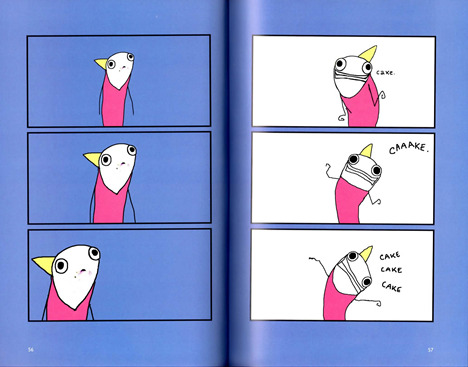
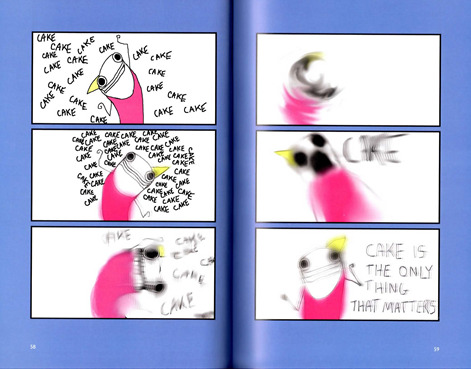
No, that’s not a mistake of my scanner, it’s printed that way in the book; while a little difficult to read, I think it conveys an emotional whirlwind with an immediacy that helps the reader understand just how much untamed tenacity is bubbling beneath the surface for this child character through the remainder of this chapter.
Another tactic that Brosh employs, that seems like a holdover from her work’s origin as an online blog, is her use of a colored filter over a panel to illustrate distress or another intense emotion. In the same chapter retelling her story of the “helper dog,” Brosh lists the myriad and often confounding behavior issues the new dog frequently displays, like her visceral and adverse reaction to other dogs. Brosh posits that the new dog must simply be unable to comprehend or abide by the fundamental existence of other dogs in the world. To depict the abrupt and unpredictable change in this dog’s mental state, Brosh uses a red tinted filter, along with grumpy-looking smiley faces and hand-written text over her base illustration of her new dog lunging toward another dog in the distance, teeth bared.

You can almost hear the Kill Bill sirens going off in the background.
While Brosh’s artistic approach is reminiscent of internet memes, it also resembles the cartoon-y illustrated style of altered mental states in comics. In One! Hundred! Demons!, Barry juxtaposes alternating bright contrasting colors with radiating squiggly lines in a few of her panels to symbolize the acid trip she and her truncated crush are having on their roam through China Town and Skid Row.
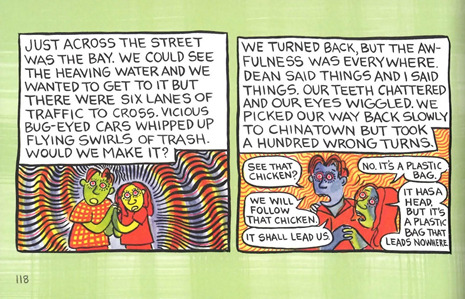
Instead of giving the audience a sense of almost seeing through the perspective of her dog’s psyche, like Brosh does, Barry’s interpretation of her own childhood experience makes the reader feel a little like a sober friend along for the ride, understanding what’s happening, but not able to reach quite the same level of empathy.
Although comics are typically regarded as a reading material relegated to childhood hobbies, books that fall between the borders of comics and illustrated novels, like Hyperbole and a Half, prove their usefulness as a narrative medium, and for readers afraid of being seen reading a full-blown comic—or have never even attempted it, can consider them the shallow end of the comics pool, a lighter commitment than the image-heavy ocean of traditional comics.
Brosh, Allie. Hyperbole and a Half: Unfortunate Situations, Flawed Coping Mechanisms, Mayhem, and Other Things That Happened. Gallery Books, 2019.
ISBN: 978-1-4767-6459-7
10 notes
·
View notes
Photo









NYFW SPRING 2015 - OSCAR DE LA RENTA (DETAILS)
3K notes
·
View notes
Photo






while i was at naeem khan's showroom last week manning the makeup test on behalf of nars, i was able to get a full-in preview of the spring 2015 collection days before it walked the runway. it was a real feast for the eyes. if you aren’t familiar with his work, khan is known for red carpet dressing — gowns upon gowns featuring intricate detailing using the most luxurious materials — but this season was a step away from what he has done in the past with an approach to sportswear. think: sheer-panel sweatshirts, silk sweatpants, and sequined t-shirts. obviously, he threw in a few floor-length dresses because how could he not, but the overall effect created a more relaxed (but not what we could consider casual) version of his typical.
see also: his showroom bathroom. definitely click that link. you’re welcome.
160 notes
·
View notes
Text
So many men have internalized the lie that they have uncontrollable sex drives, and no way to control their anger. They aren’t ashamed of their abusive behavior because they see it as a something natural to them and maybe even central to their masculinity. It’s scary as hell.
205K notes
·
View notes
Text
[autumn]
The season of cardigans, sweaters and scarves is approaching.
2 notes
·
View notes
Photo
"Uranographia: totum caelum stellatum" Johannes Hevelius, 1687
Andromeda, Aquaris, Aquila, Bootes, Cassiopeia, Draco, Pegasus, Orion
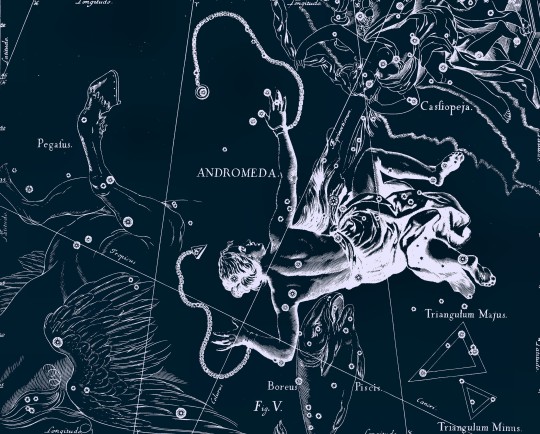
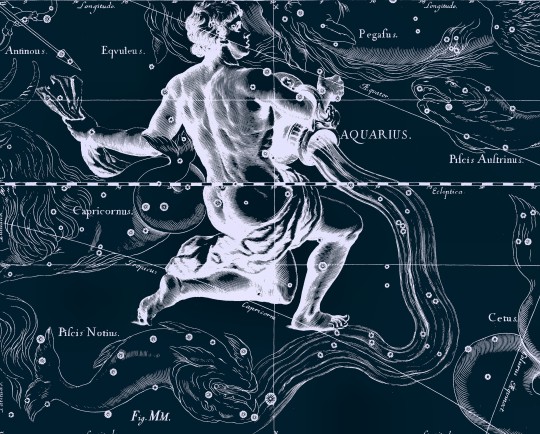






43K notes
·
View notes
Text
when your teacher asks u why ur late to class

344K notes
·
View notes
Text
R.I.P. The 2976 American people that lost their lives on 9/11 and R.I.P. the 48,644 Afghan and 1,690,903 Iraqi and 35000 Pakistani people that paid the ultimate price for a crime they did not commit
2M notes
·
View notes

































